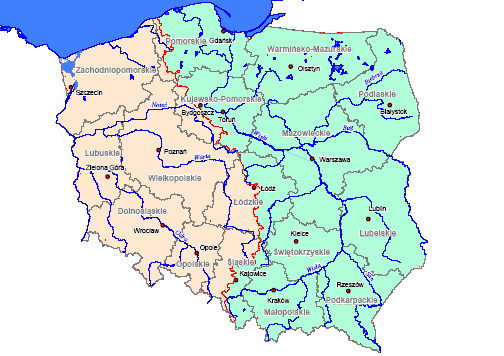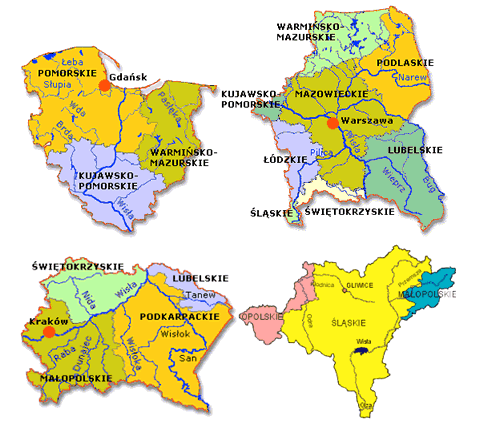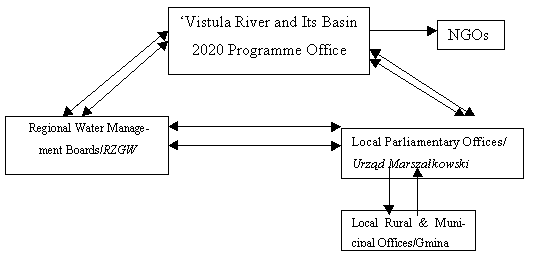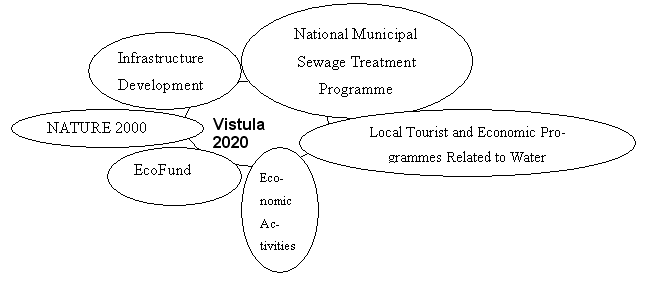Introduction
Historical
Outline of the
Programme
Legal
foundations of
the PROGRAMME
PROGRAMME
Range
PROGRAMME
Design System
PROGRAMME
Structure
Anticipated
Conflicts
External
Preconditions
Strengths
and Weaknesses
of the PROGRAMME
The 'Vistula and Its Basin
2020' Programme, later referred
to as the 'Vistula 2020 Programme'
or the PROGRAMME, was initiated
by the Union of Vistula River
Towns, an organisation that
has managed to attract to
the idea a number of local
authorities, governmental
and non-governmental organisations
and other institutions. Their
mutual interest in the programme
resulted in the so-called
Toruń Agreement signed on
2 June 2000.
The 'Vistula and Its Basin
2020' is an investment capital
programme.
Historical
Outline of the
Programme
Among the many reasons underlying
the need to launch such a
programme there were the
following:
-
to continue the
work in progress
undertaken by a number
of governmental and
local self-government
institutions, research
institutes, associations
and others.
-
to positively relieve
the pressure felt
by local self-government
authorities to solve
fundamental water
economy problems;
this pressure was
instrumental in the
self-governmental
initiative to set
up an Office to develop
the PROGRAMME
-
To compensate for
the lack of any direct
united action related
to water economy,
including a total
lack of water management
policy or strategy
-
To finally create
an unambiguous definition
and classification
of the problems present
in the Vistula River
basin and to arrive
at the ways to solve
them, mainly concentrating
on finding funds
to finance the work
to be undertaken
-
To co-ordinate various
activities and prevent
possible conflicts
from arising.
>> back
to the top
Legal
foundations of
the PROGRAMME
The PROGRAMME is based on
the following legal foundations:
-
The constitutional
sustainable development
principle Acts
related to water
economy and environmental
protection, such
as:
-
EU directives-first
and foremost-the
EU Directive
on the Quality
and Protection
of Water and
Pollution Control
-
Polish ecological
policy
-
Agreements and
international
conventions,
including:
-
Convention
on Wetlands, which
have an international
importance, especially
as the natural
environment for
water birds (RAMSAR
1971),
-
Convention
concerning the
Protection of
the World Cultural
and Natural Heritage (PARIS
1972),
-
Convention
on International
Trade in Endangered
Species of Wild
Fauna and Flora (WASHINGTON
1973),
-
Convention
on the Conservation
of Migratory
Species of Wild
Animals (BONN
1979),
-
Convention
on the Protection
of Species of
Wild European Fauna
and Flora and
their Natural
Environments
(BERN 1979),
-
Convention
on Biological
Diversity (RIO
de JANEIRO 1992),
-
Environmental protection
projects (of 2003)
designed by the regional
self-government authorities,
-
Integrated Operational
Programmes of Regional
Development designed
by the local parliament
offices for the years
2004 – 2006 taking
into account the
long-term needs of
the Vistula 2020
Programme;
-
National Program
of Municipal
Sewage Treatment
System
-
The Ordinance of
the Chair of
the Council of
Ministers to
establish the
Ministry of Environmental
Protection
-
The Polish Parliament
resolution to
embark on an
investment undertaking
called Nieszawa
– Ciechocinek
water drop of
22 December 2000
-
Toruń Agreement
of 2 June 2000
>> back
to the top
PROGRAMME
Range
The PROJECT embraces
the whole area said to constitute
the Vistula river basin.
DIVISION OF
POLAND INTO TWO DRAINAGE
BASINS

Nearly
the whole area of Poland
(97,3%) falls within the
drainage catchment of the
Baltic Sea in the basins
of the Vistula (53,9%), the
Oder (34%), the Baltic Coastland
rivers (11%) and the Nyoman
(0,8%). According to the
new division, in compliance
to the Ordinance of the Council
of Ministers of 10 December
2002 (Dziennik Ustaw, No
232 entry 1953 – an entry
in the official gazette announcing
current legislation),
the Baltic Coastland rivers
belong to the Oder basin
(taking up 40% of Poland’s
area) and to the Vistula
(59% of the total area),
respectively. Thus, the area
of Poland has been divided
into two river basins.
-
|
Trunk
Rivers
in the
Vistula
Basin
|
|
Rivers
|
Length
(km)
|
Basin
Area
(km2)
|
|
Wisła/
Vistula
|
1
047
|
194
424, including
168 699 in
Poland
|
|
Bug
|
772
|
39
420, including
19 284 in
Poland
|
|
Narew
|
484
|
75
175, including
53 873 in
Poland
|
|
San
|
443
|
16
861, including
14 390 in
Poland
|
|
Pilica
|
319
|
9
273
|
|
Wieprz
|
303
|
10
415
|
Territorial Division of
the Programme Area:
According to the Ordinance
of the Council of Ministers
of 10 December 2002, the
Vistula basin has been divided
into four water regions, falling
within the jurisdiction and
supervision of regional water
management boards (RZGWs):
-
the water region
of the Small
Vistula/Mała
Wisła (RZGW Gliwice) –
embracing the
area of the Vistula
basin from its
source up to
the Przemsza
river mouth;
-
the water region
of the Upper
Vistula/Górna
Wisła (RZGW Krakow) -
embracing the
area of the Vistula
basin from the
Przemsza river
mouth up to the
Sanna river mouth;
-
the water region
of the Middle
Vistula/¦rodkowa
Wisła (RZGW Warszawa) -
embracing the
area of the Vistula
basin from the
Sanna river mouth
up to the village
of Korabniki;
-
the water region
of the Lower
Vistula/Dolna
Wisła (RZGW Gdańsk) -
embracing the
area of the Vistula
basin from the
village of Korabniki
up to the Vistula
sea estuary and
also the basin
of Baltic Coastland
rivers;

MAPS OF THE VISTULA BASIN
WATER REGIONS (RZGW Gliwice
– the total area of the
Upper Oder and the Small
Vistula basins).
This division reflects the
natural conditions of the
basin and will be included
in the PROGRAMME.
Additionally, the PROGRAMME
will include the Żuławy/Marshland
area because of its uniqueness
and the advanced work on
the Żuławy Law, which will
constitutive an integral
part of the Vistula Law.
The PROGRAMME demands international
co-operation in the areas
where Poland shares its water
basins with its neighbouring
countries.
The creators of the PROGRAMME
aim to correlate the water
regions with the administrative
division of the country in
the future.
>> back
to the top
PROGRAMME
Design System
The ‘Vistula
and Its Basin’ Programme
Office accepted the following
system to design the PROGRAMME:
-
Protection
of water
sources and
underground
and surface
water purity
control;
-
Emergency
prevention
(flood and
drought prevention);,
-
Environmental
protection
and protection
of natural
resources
and landscape;
-
Economic
development
of the basin
(hydropower
engineering,
inland navigation
and bridge
crossings,
tourism,
etc.).
-
Regional
government offices,
-
Regional
Water Management
Boards (Regionalny
Zarz±d Gospodarki
Wodnej - RZGW)
The data
collection and research system
used by the PROGRAMME initiators
can be presented as follows:

>> back
to the top
PROGRAMME
Structure

The PROGRAM must
be constructed in such a
way that it will stimulate
initiation of various local
programmes and economic initiatives
functioning in accord with
the sustainable development
principle.
The PROGRAMME
should mainly incorporate
such local activities without
which local development will
not be possible. For example,
prospective reactivation
of tourist activity on the
Vistula requires its waterways
to be regulated and water
treatment plants to be built,
etc.
>> back
to the top
Anticipated
Conflicts
Any
action provokes conflicts
of interests. The PROGRAMME
designers anticipate the
following:
-
conflicts between
the economic
and environmental
lobbies - like
in case of the
Nieszawa Dam,
Nature 2000 Programme,
the Lower Vistula
Stepped Falls
-
conflicts of
local interests
and loyalties
in the basin
area
-
conflicts between
the governmental
and self-government
bodies
-
international
conflicts
The PROGRAMME initiators
aim to facilitate compromise
in the areas of conflict.
Without reaching mutual agreements,
the PROGRAMME cannot possibly
be implemented.
>> back
to the top
External
Preconditions
Being a branch
of science, water economy
also belongs to those sectors
of the national economy that
are closely connected with
other areas of economic activity.
Generally speaking, the main
aim of water economy is to
rationally shape and take
advantage of the underground
and surface water sources.
The rational forming and
use means here that the sources
available are used in an
optimal way, according to
established criteria justified
socially and economically.
Activities related
to water economy boil down
to those undertaken by the
government and the national
regional and local administration
in order to properly:
-
make
quantitative and
qualitative description
of the water sources
according to the
needs of their users
and consumers, taking
protection of the
natural environment
into account;
-
control
overbank discharges
at flood time.
There are
some basic principles
governing water management
the world over:
-
drainage
basin principle -
assuming that
water management
should be exercised
within the areas
of respective
water basins;
-
active
community principle -
engaging members
of the community
in the workings
of the system
of control over
the processes
of utilisation
and development
of water sources;
-
administration
principle -
consisting in
the State's statutory
control of and
supervision over
the water resources
in the country;
-
central
planning and
funding principle -
leaving strategic
decisions and
basic financial
resources in
the hands of
central authorities;
-
market
principle -
aiming to put
water economy
on the market.
>> back
to the top
Strengths
and Weaknesses of the PROGRAMME
Strengths and Weaknesses
Analysis:
Strengths:
-
gathering all important
governmental and
non-governmental
circles around a
shared idea of the
PROGRAMME and its
prospective implementation;
-
a global PROGRAMME
for the entire basin
stands a better chance
than dispersed small-scale
initiatives;
-
a high degree of
social acceptance
to the PROGRAMME
by local communities
and authorities;
-
co-ordination of
investment activities
conducive to effective
financing of individual
undertakings and
decreasing the amount
and range of encroachment
upon the natural
environment
Weaknesses:
-
Low degree of approval
by decision-makers
at various levels
with regards to allotting
funds, the reason
being the PROGRAMME'S
long-term planning
and the results to
be seen long after
the decision makers'
term of office;
-
Conflicts of interests
and loyalties mentioned
above
|